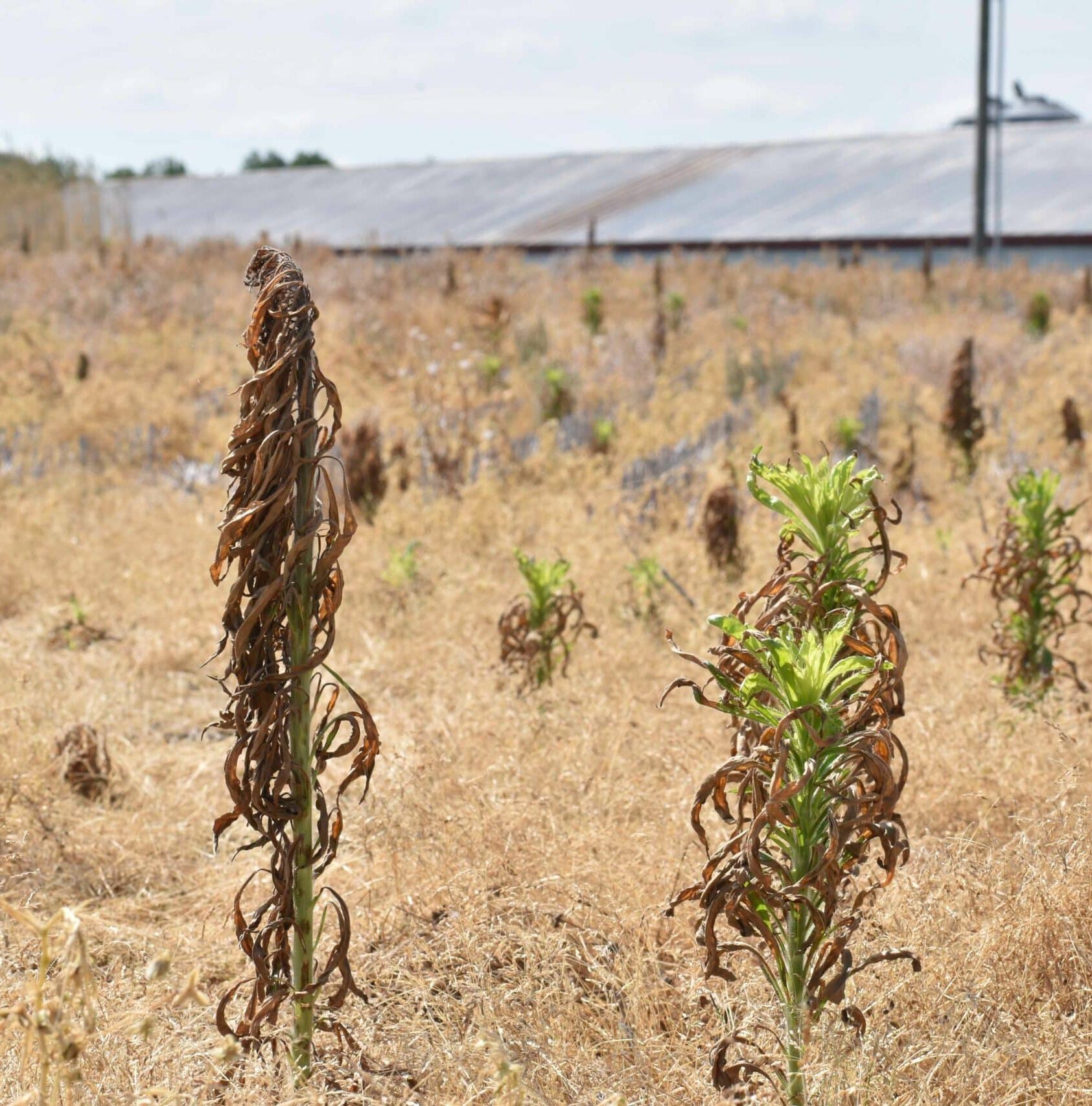Herbicide Resistance
The Basics of Herbicide Resistance
Over the past two decades, herbicide-resistant weeds have increased globally, creating major economic consequences for farmers and pushing both the private and public sectors to find innovative solutions to this crisis. Before widespread resistance, farmers could control problematic weeds relatively easily with herbicides. Roundup Ready and other herbicide-resistant crop technologies helped drive this success. By the mid-2000’s, these simple herbicide solutions were quickly becoming ineffective, with several problematic herbicide-resistant weeds spreading onto more farms and into new regions. (Examples of common herbicide resistant weeds across the U.S. are provided in Figure 1.) Multiple approaches to managing resistant weeds were becoming necessary. This led to more herbicide use, the need for tillage or other mechanical options, and a search for more innovative technologies.
In the U.S., most farmers continue to rely on herbicides as the primary approach to managing weeds in major field crops. Not only does this approach cost more per acre than ever before, but each year, successful weed control with herbicides alone becomes less reliable and likely. It is not uncommon for farmers in some crops and regions to make at least three or more herbicide applications per growing season, with multiple products applied at each application timing. Current expert recommendations call for using overlapping residual products in addition to over-the-top or POST applications in corn, soybean, and cotton. The latest herbicide-resistant technologies, which allow POST applications of certain Group 4 herbicides such as 2,4-D and dicamba to soybean and cotton, are already beginning to fail because of regional herbicide-resistance problems emerging.
Cross-resistant and multiple-resistant Palmer amaranth, waterhemp, Italian ryegrass, barnyardgrass, and others are on the rise, and a more ominous resistance mechanism called “metabolic resistance” has been identified in several weed species and for several herbicide groups. In this first education module, we will cover the Basics of Herbicide Resistance where you will learn:










Authors
William Curran, Penn State University (emeritus)
Claudio Rubione, GROW
Editors
Mark VanGessel, University of Delaware
Emily Unglesbee, GROW
Reviewers
Patrick Tranel, University of Illinois
Franck Dayan, Colorado State University
Citations
Ackroyd, V., T. Besancon, J. Bunchek, C. Cahoon, R. Chandran, W. Curran, M. Flessner, A. Klodd, D. Lingenfelter, S. Mirsky, M. Ryan, D. Sandy, M. VanGessel, K. Vollmer, and M. Ward (2019) A Practical Guide for Integrated Weed Management in Mid-Atlantic Grain Crops. https://growgettingstg.wpenginepowered.com/a-practical-guide-for-integrated-weed-management-in-mid-atlantic-grain-crops/.
Blois M (2022) Following several fallow decades, herbicide companies are searching for new modes of action. Chemical and Engineering News. https://cen.acs.org/environment/pesticides/crop-protection-herbicide-mode-action-glyphosate/100/i22.
Bobadilla, LK and PJ Tranel (2023) Predicting the unpredictable: the regulatory nature and promiscuity of herbicide cross resistance. Pest Management Science https://doi.org/10.1002/ps.7728
Bobadilla LK, Giacomini DA, Hager AG, Tranel PJ (2022) Characterization and inheritance of dicamba resistance in multiple-resistant waterhemp (Amaranthus tuberculatus) population of Illinois. Weed Science 70:4-13 doi.org/10.1017/wsc.2021.76
Coble HD, Mortensen DA (1992) The threshold concept and its application to weed science. Weed Technology 6:191-195. doi.org/10.1017/S0890037X00034552
Cousens R (1987) Theory and reality of weed control thresholds. Plant Protection Quarterly 2:13-20 https://caws.org.nz/PPQ12/PPQ%2002-1%20pp013-20%20Cousens.pdf
Delye C, Jasieniuk M, Le Corre V (2013) Deciphering the evolution of herbicide resistance in weeds. Trends in Genetics 29:649-658 doi.org/10.1016/j.tig.2013.06.001
Edwards CB, Jordan DL, Owen MD, Dixon PM, Young BG, Wilson RG, Weller SC, Shaw DR (2014) Benchmark study on glyphosate-resistant crop systems in the United States. Economics of herbicide resistance management practices in a 5-year field-scale study. Pest Management Science 70:1924-1929 doi.org/10.1002/ps.3759
Evans JA, Tranel PJ, Aager AG, Schutte B, Wu C, Chatham LA, Davis AS (2015) Managing the evolution of herbicide resistance. Pest Management Science 72:74-80 doi.org/10.1002/ps.4009
Evans CM, Strom SA, Riechers DE, Davis AS, Tranel PJ, Hager AG (2019) Characterization of waterhemp (Amaranthus tuberculatus) population from Illinois to herbicides from five site-of-action groups. Weed Technology 33:400-410 doi.org/10.1017/wet.2019.19
Gaines TA, Duke SO, Morran S, Rigon CA, Tranel PJ , Kupper A, Dayan FE (2020) Mechanisms of evolved herbicide resistance. Journal of Biological Chemistry 295:10307-10330 doi.org/10.1074/jbc.REV120.013572
Heap, I (2023) The International Herbicide-Resistant Weed Database. Online. Saturday, June 17, 2023. Available www.weedscience.org
Norris RF (1999) Ecological implications of using thresholds for weed management. NY, The Haworth Press, pp. 31-58. In Buhler DD (1999) Expanding the Context of Weed Management, Journal of Crop Production, 2:1, 1-7 doi.org/10.1201/9781003075202
Riechers DE, Soltani N, Chauhan BS, et al. Herbicide resistance is complex: a global review of cross-resistance in weeds within herbicide groups. Weed Science. 2024;72(5):465-486. doi:10.1017/wsc.2024.33
Shaner DL, Beckie HJ (2014) The future of weed control and technology. Pest Management Science 70:1329-1339 doi.org/10.1002/ps.3706
Soltani N, Geddes C, Laforest M, Dille JA, Sikkema PH (2022) Economic impact of glyphosate-resistant weeds on major crops grown in Ontario. Weed Technology 36:629-635 doi.org/10.1017/wet.2022.72
Suzukawa, AK, LK Bobadilla, C Mallory-Smith, and C. Brunharo. 2021. Non-target-site resistance in Lolium spp. Globally: A review. Front Plant Sci. 11:609209.
Van Horn CR, Moretti ML, Robertson RR, Segobye K, Weller SC, Young BG, Johnson WG, Schulz B, Gaines T, Green AC, Jeffery T, Lespérance M, Tardif T, Sikkema P, Hall JCl, McLean M, Westra P (2018) Glyphosate resistance in Ambrosia trifida: Part 1. Novel rapid cell death response to glyphosate. Pest Management Science 74:1071–1078 doi.org/10.1002/ps.4567
Weirich JW, Shaw DR, Owen MD, Dixon PM, Weller SC, Young BG, Wilson RG, Jordan DL (2011) Benchmark study on glyphosate-resistant cropping systems in the United States. Part 5: Effects of glyphosate-based weed management programs on farm-level profitability. Pest Management Science 67:781-784. doi.org/10.1002/ps.2177
Westwood JH, Charudattan R, Duke SO, Fennimore SA, Marrone P, Slaughter DC, Swanton C, Zollinger R (2018) Weed management in 2050: Perspectives on the future of weed science. Weed Science 66:275-285.doi.org/10.1017/wsc.2017.78























































































